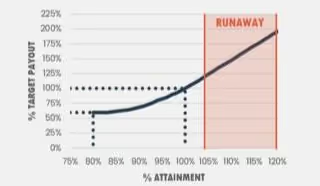.avif)
Blog
In the Trenches: Sales Compensation Plans that Work in the Real World
March 31, 2023

.avif)
Key Insights
Preface:
Given that sales comp is the largest component of any organization’s total labor costs–around 70%–, one can draw the logical conclusion that businesses spend a lot of time and resources perfecting it.
Here’s the reality! They don’t.
Sales compensation as a subject of study is still developing: Best practices are yet to be established.
This study done by Deloitte’s is an eye-opener: According to the 2020 Global Human Capital Trends survey, 56 % of the organizations felt the need to redesign their compensation strategy in the last three years because their plans couldn't keep up. 64% are in the process of redesigning the strategy as we speak. 69 % of organizations have stated that the changing nature of compensation expectations and strategies is “important” or “very important” to their success and growth over the next 12 to 18 months. However, only 9 percent report being “very ready” to address this trend.
The summary – Organizations are struggling to design, implement and manage a working sales compensation plan.
If you're grappling with the challenge of devising a sales compensation plan that effectively motivates your key contributors, you may be wondering how to tackle it. However, there's no need to fret as we've taken the initiative to explore this intricate subject. Discover more about two sales compensation plans that have proven successful in real-world scenarios by reading this article.
Introduction:
Sales Compensation is basically performance-based compensation – exclusive of the base salary that a rep might receive – and is directly connected to the reps’ goals and milestones.
A good Sales Compensation plan will tell the rep in clear terms what they need to do in order to earn more. By setting clear and realistic goals between sales representative vs sales associate, a Sales Compensation plan drives them towards profitability while also ensuring fair and equitable broad based compensation across the team.
If you are still wondering whether laying out your company’s goals clearly and communicating them with your sales team makes a difference, then this study from Mckinsey is for you:
When a company challenged one of their teams with a clear goal to achieve a $40 million target in 40 days, the team not only hit the mark, but crossed the mark several days in advance.
Success stories like these are the reason why sales incentives are becoming an increasingly popular way to motivate salespeople and keep them on track.
While the most effective tool in the sales manager’s toolbox is a sales incentive, it is also the most difficult tool to put to use, especially without clear sales targets examples. It is effective because incentives can drive better business outcomes by essentially treating salespeople like company owners!
What this means is that by giving reps a slice of the company’s revenue that they help generate, you can make them feel happier and more invested in the company’s growth.
Go-to IC Models- Bonus-based and Commission Based Structures:
Organizations today are diverse, to say the least. So are their IC plans and pay philosophies. There is no ‘one size fits all’ compensation plan that sales leaders can pick off the shelf, and customization is key. However, growth leaders often choose between the two most popular models: Bonus-based and Commission-based sales compensation models. To help you choose, we’re breaking down the basics of bonus and commission based pay structures, the pros and cons of each, and when to use each one.

Bonus-based Incentives:
Bonus payments have survived the test of time. They are essentially fixed amounts paid to reps when they reach specified targets. They can be paid on a monthly, quarterly, bi-annual and annual basis depending on the organization’s goals. Some companies also give bonuses to entire departments in order to achieve broader goals.
Established companies with predictable growth and higher accuracy in target/quota choose to go with a bonus-based IC plan. Sales reps are allocated individual quotas for one or more products based on the historical sales data in their territories, growth expectations and market conditions. Reps then get a bonus against quota achievement.
It’s important to note that companies do not have to see bonuses as ‘all-or-nothing’ payments. If the quota is not met, sales reps can still earn a percentage of their bonus, which helps them stay motivated.
However, there are a few issues with bonus-based payments that need to be addressed. Let’s try and understand these problems with the help of these payout curves.
1. Bonus increases significantly at higher attainment levels-

Bonus payout continues to increase significantly as reps exceed their goals. Once the rep hits the 100% mark, the curve becomes steeper. What this means is that the rep receives disproportionately higher bonus payouts as compared to attainment levels. While it is fair for a successful sales rep to be well-compensated, a good year could significantly hit a company’s budget.
2. Payouts are asymmetrical around 100% attainment-

After the 100% mark, the payout curve is no longer linear. The convex payout curve after the 100% mark means that the payouts are asymmetrical. To put this into perspective, a 2% drop in attainment (from 100% to 98% attainment) leads to a 1.5% decrease in payout whereas a 2% gain in attainment (from 100% to 102% attainment) would lead to a 4% increase in payout. This imbalance in payouts for the same percentage change in attainments is not ideal for a well-designed IC plan.
3. The payouts are steep above and below the goal and flat around the goal-

The payout curve is steep far-above and far-below the goal, but flat around the goal. This is understandable. It encourages reps who are far behind their goal attainment to perform better, and reward the reps who are far ahead of their goal.
However, it is crucial that the goals set by companies are equitable. The purpose of an incentive compensation management plan is to encourage reps to hit their goal, and this is the point where the payout curve should be the steepest.
It is also important to understand that there are very few reps who are way behind or way ahead of their goal, and by becoming more steep at these thresholds, the payout curve ignores the majority of employees who fall somewhere around the goal.
Commission-based Incentives:
The first card from the deck! Commissions are the most common when it comes to handing out incentives. Essentially, reps earn commission as a percentage (e.g., 5% of sales revenue) for every sale they make.
More often than not, commissions are not capped, which can be a major motivation factor for reps. Some companies may also introduce accelerators- higher commission rates once the rep hits quota- to reward performance.
These efforts enhances the chances of achieving the targeted annual compensation for the sales reps.
Normally, you would see growing businesses using this model because it is easy to implement for leaders and easy to understand for reps.
Keeping this in mind, let’s look at the 9 best sales commission structures that organizations today swear by-

1. Base rate only commission
Example: The company’s salespeople each earn $1,000 a week no matter how many sales they make.
In this case, the commission is fixed and no further calculations are necessary.
2. Base salary plus commission
Example: A salesperson earns $500 a month in salary with 10% commission, or $500 for $5,000 worth in sales. If he sells $20,000 of product in one month, he earns $2,500: $500 in salary and $2,000 in commission.
Calculation for base rate only commission: Commission Percentage * Amount Sold = Commission Total.
In this case, the base salary is usually too low to support someone’s household entirely but does provide a stable guaranteed income when sales are low.
3. Draw against a commission
Example: A salesperson is expected to earn $4,000 a month in commission and receives $2,000 a month in draw (salary). If they met their $4,000 goal, they earn $2,000 more, the amount over the draw. If they earn only $1,000, they owe the company $1,000, the amount under the draw.
Calculation for draw commission: Commission Total - Draw = Commission Owed.
4. Gross margin commission
Example: A salesperson is selling a $120,000 car that costs $70,000 to make. The gross margin is $50,000. The salesperson earns 5% on the margin or $2,500 in compensation.
Calculation for gross margin commission: Total Sale Price - Cost = Gross Margin. Gross Margin * Commission Percentage = Total Commission.
In this case, salespersons are not likely to give out more discounts as the amount at which a product is sold influences their earning.
5. Residual commission
Example: A salesperson lands a large account. As long as that company pays its premiums of $4,000 a month, the salesperson receives a 5% commission or $200 every month.
Calculation for residual commission: Payment * Commission Percentage = Total Commission.
The benefit is that salespeople are motivated to retain customers this way.
6. Revenue commission
Example: A car salesperson sells a $20,000 vehicle and earns 4% of the sales. They receive $800 in revenue commission for that sale.
Calculation for revenue commission: Sale Price * Commission Percentage = Total Commission.
7. Straight commission
Example: A salesperson that sells vacation home rentals earns $100 for every booking. The more time he puts in, the greater the chance of making a sale.
Calculation for a straight commission: Sales x Commission Rate = Income.
8. Tiered commission
Example: A salesperson's base commission is 5% up to a total of $100,000 in sales. That commission increases to 7% for total sales between $100,001 and $200,000. If they go beyond that and perform over $200,001, they earn 10% in commission.
With this structure, a salesperson is motivated to exceed sales goals.
9. Territory volume commission
Example: Two salespeople are expected to sell $50,000 in product each month in a particular region. One sells $30,000 while the co-worker sells $20,000. Since the total goal has been met, they split the 10% commission, earning $2,500 each.
Have you heard about Annual Incentive Plan Examples. Check What are Annual Incentive Plans, Everything you Need to Know for more information.

Bonus vs Commission: How to choose the right sales compensation plan?
Bonus is a best practice for:
- Established companies and mature revenue teams
- Sales roles with administrative responsibilities
- Non-selling employees
- Territories with a significant difference in selling opportunities
Commission is a best practice for:
- Earlier stage companies and growing revenue teams
- New product launches
- Sales roles involving more selling and prospecting
- Territories with equal selling opportunities
How much do you know about pharma sales compensation? Read more about the topic in Best Practices and Strategies for Pharmaceutical Sales Compensation.
Final Thoughts:
Both bonus-based and commission-based IC models will allow you to compensate your reps fairly and motivate them to achieve set goals. The key is to come up with a SaaS sales compensation plan that works the best for you and your unique company goals.
There are some ways that can help you decide which commission structure is ideal for your organization. For example, focusing on making your sales process effective, designing your commission structure around company goals and benchmarking with industry standards can help.
It is not easy to religiously stick to one structure and more often than not, companies choose to opt for a hybrid option. For example, an established company may use commissions when they launch a new product or try to penetrate into a new market. On the other hand, growing companies may give out bonuses to encourage employees outside the sales team.
Whatever your sales commission structure is, Kennect’s ICM solution, including a powerful sales commission calculator, provides real-time updates on your sales compensation program with a No-code plan builder that helps you customize your IC plans and deliver at 100% accuracy!
Book a demo with us today!
ReKennect : Stay ahead of the curve!
Subscribe to our bi-weekly newsletter packed with latest trends and insights on incentives.
Thank you! Your submission has been received!
Oops! Something went wrong while submitting the form.
Your data is in safe hands. Check out our Privacy policy for more info













